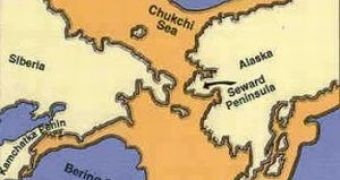Bering Land Bridge seems to have been flooded into the Arctic Ocean about 11,000 years ago, about 1,000 years earlier than previously thought, closing off the major route for human migration from Asia to the Americas. Till now, studied sediment cores were collected from locations where the accumulated sediment layers were only about one centimeter (about 0.4 inch) every millennium. These samples offered very limited information about climate change and sea level rise in the Arctic Ocean, being tricky even to distinguish one millennium from the others.
In three new core sites found in Chukchi Sea ( off North and West Alaska), the sediment accumulation is 100 times greater than at previous sites, till now, the highest found in Arctic region, bringing much more information than the previous sites. The Chukchi Sea in situated where 20,000 years ago, before the sea level rising, was an exposed land bridge. During that time the area had a more continental climate.
When sea level rose, the Pacific Ocean waters dashed through the Bering Strait (between Russia and Alaska), where the sill depth is 50 meters (165 feet), affecting the freshwater and nutrient balance of the Arctic. The classical view of migration route to America via a exposed shelf may be somehow changed by the latest findings, forcing to be taken in account also a maritime route. "Although we have only a few cores, this is the first evidence of flooding of the Chukchi Sea by 11,000 years ago, at least 1,000 years before previously thought," said Lloyd Keigwin of the Woods Hole Oceanographic Institution (WHOI).
"The new data are also consistent with data from other recent studies, and show potential for developing ocean and climate histories of this region."
7,000 years ago, the erosion in Alaska decreased deeply and 4,000 years ago biological productivity declined, due maybe to an increased sea ice or decreased nutrient supply from the Bering Strait. "Our research suggests there was more ice present in the region during the last glacial period than previously thought," said co-author Neal Driscoll, a professor in the Geosciences Research Division at Scripps Oceanography at UC San Diego. "Evidence of an increased sedimentation rate, along with deep valleys cut into the continental shelf when sea level was rising rapidly during the deglaciation, helped guide us to that result. Additional ice in this region of the Arctic is an important discovery, and is significant in helping our understanding of climate models, circulation and precipitation during glacial periods."
The study relied much on the analysis of the foraminifera (a group of protists- single cell animals) skeletons that can be linked to specific water and atmospheric temperatures. The foraminifera fossils were also radiocarbon dated.

 14 DAY TRIAL //
14 DAY TRIAL //